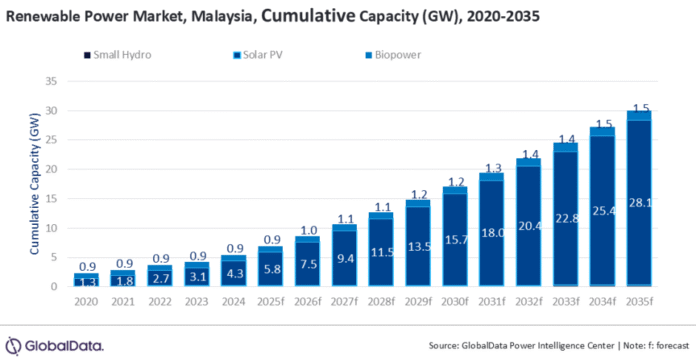Malaysia is intensifying its shift towards renewable energy as part of efforts to reduce dependence on fossil fuels and build a more sustainable power sector. The government has set a target to increase the share of renewable energy to 40 percent of the total installed capacity by 2035 and achieve net-zero emissions by 2050. In line with these goals, the country’s cumulative renewable capacity is expected to reach 30GW by 2035, growing at a compound annual growth rate (CAGR) of 16.8 percent during 2024 to 2030, according to GlobalData.
Renewable power generation in Malaysia rose from 5TWh in 2020 to 9.8TWh in 2024, recording a CAGR of 18.5 percent. This growth is expected to continue, reaching 51.1TWh by 2035, with a CAGR of 16.2 percent between 2024 and 2035. This progress has been enabled by the introduction of clear policy frameworks such as the National Energy Transition Roadmap (NETR) and the Malaysia Renewable Energy Roadmap (MyRER), which have unlocked investment opportunities and demonstrated strong government commitment to clean energy development.
Malaysia’s renewable energy potential is supported by abundant natural resources across the countryside. Bioenergy, especially derived from palm oil, remains a key component of renewable consumption. Solar PV has emerged as the leading renewable power technology, driven primarily by the Net Energy Metering (NEM) scheme, which allows surplus energy generated from solar systems to be exported to the grid on a one-for-one basis, encouraging residential and industrial adoption.
Despite being a net exporter of electricity, Malaysia remains reliant on thermal energy, much of which is based on imported coal due to insufficient domestic mining capabilities. In addition, oil production is expected to decline as local reserves deplete, raising concerns about energy security. These issues have slowed the growth of power generation and highlighted the need for diversification.
In response, the government is promoting renewable energy sources like solar and biomass, supported by initiatives such as the LSS programs and rooftop solar incentives. Hydropower continues to play a vital role, particularly in eastern Malaysia, while bioenergy from palm oil waste and municipal solid waste is gaining momentum.
The development of renewable energy technologies is being supported by government grants to offset high initial costs and uncertainties associated with emerging technologies. These investments are crucial to overcome financial and technological challenges and facilitate wider market integration. However, securing financing remains a major obstacle due to high perceived risks and limited expertise among financial institutions. To address this, the government is working to implement stronger policies and create a sustainable investment environment that fosters long-term renewable energy growth.
GreentechLead.com News Desk

